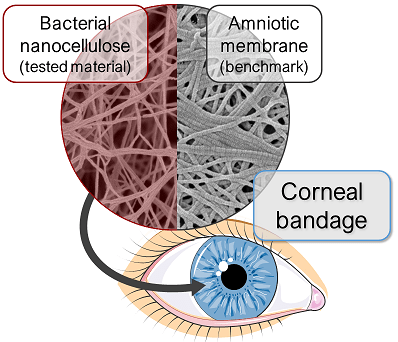
Hot off the press: new publication in Biomaterials Science!
We are happy to announce some good news amidst the COVID-19 crisis: Our paper “Bacterial nanocellulose as a corneal bandage material: a comparison with amniotic membrane” has been published in Biomaterials Science.
This work has been performed in collaboration with ophthalmologists from Centro Barraquer and explains the potential use of bacterial nanocellulose as a new corneal bandage material. Congratulations to all the authors: Irene Anton-Sales, Justin Christopher D’Antin, Jorge Fernández-Engroba, Victor Charoenrook, Anna Laromaine, Anna Roig ORCID logo and Ralph Michael.
Abstract: Corneal trauma and ulcerations are leading causes of corneal blindness around the world. These lesions require attentive medical monitoring since improper healing or infection has serious consequences in vision and quality of life. Amniotic membrane grafts represent the common solution to treat severe corneal wounds. However, amniotic membrane’s availability remains limited by the dependency on donor tissues, its high price and short shelf life. Consequently, there is an active quest for biomaterials to treat injured corneal tissues. Nanocellulose synthetized by bacteria (BNC) is an emergent biopolymer with vast clinical potential for skin tissue regeneration. BNC also exhibits appealing characteristics to act as an alternative corneal bandage such as; high liquid holding capacity, biocompatibility, flexibility, natural – but animal free-origin and a myriad of functionalization opportunities. Here, we present an initial study aiming at testing the suitability of BNC as corneal bandage regarding preclinical requirements and using amniotic membrane as a benchmark. Bacterial nanocellulose exhibits higher mechanical resistance to sutures and slightly longer stability under in vitro and ex vivo simulated physiological conditions than amniotic membrane. Additionally, bacterial nanocellulose offers good conformability to the shape of the eye globe and easy manipulation in medical settings. These excellent attributes accompanied by the facts that bacterial nanocellulose is stable at room temperature for long periods, can be heat-sterilized and is easy to produce, reinforce the potential of bacterial nanocellulose as a more accessible ocular surface bandage.
bacterial cellulose, biomaterials, Biomaterials Science, corneal regeneration, new paper, research paper

